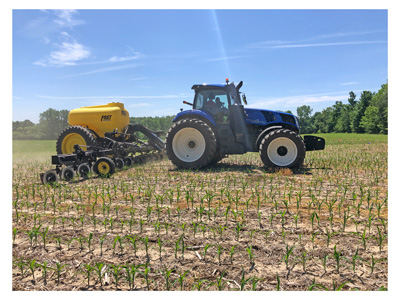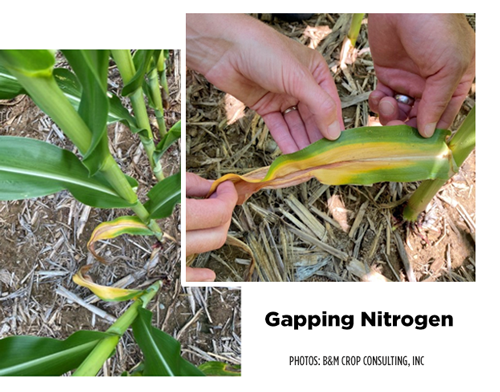The Value of In-Season Nitrogen Use

Keeping nitrogen (N) use front and center is a good season-long management consideration for corn, notes Missy Bauer, Farm Journal Field Agronomist and owner of B&M Crop Consulting, Coldwater, Mich.
Bauer’s work with the Farm Journal Test Plots over the years shows that corn requires nitrogen at various growth stages throughout the season. Some of the key times include these five stages:
1. During the first 35 days after planting, a corn crop needs a little less than 2 lb. of N per acre per day.
2. Starting around V6, N uptake increases sharply to about 4 lb. per acre per day.
3. Between V10 and V14, nitrogen demand can reach up to 8 lb. of N per acre per day.
4. At silking or R1 nutrient requirements drop back to 4 lb. to 5 lb. per acre per day.
5. From late reproductive stages and all the way to black layer, corn requires about 2 lb. per acre per day.
“Historically, farmers fall-applied anhydrous to fuel the next season’s crop or they put all their N on in the spring, but with today’s genetics we know that season-long nitrogen access is important,” she says.
Tune Into Hybrid Characteristics
To support grain fill, hybrids usually benefit from at least one in-season nitrogen application and sometimes even two depending on the growing season conditions and a hybrid’s specific characteristics.
For example, a hybrid that flexes a lot in kernel depth or size requires access to nitrogen at the end of the season to pack on starch (weight) to boost yield.
“That kernel depth is so important with today’s genetics,” Bauer says. “With some hybrids, you can have a 100-bushel-per-acre swing in yield just from kernel depth alone.” (Picture from B&M Consulting below illustrates this.)

“When I got out of school, we talked about 90,000 kernels in a bushel. Today, our hybrid plots will average 70,000 kernels in a bushel,” she says.
Bob Nielsen, Purdue University Extension specialist emeritus, reports that kernel weight for the same hybrid can vary by 20,000 kernels per bushel or more simply due to variability in growing conditions during the grain filling period.
“Consequently, the number of kernels per bushel can vary significantly among years or fields within years,” he says in the online article Estimating Corn Grain Yield Prior to Harvest.
“Average kernel weight in several of our recent trials (in Indiana) ranged from 67,000 to 94,000 kernels per 56-lb. bushel, with an average of about 76,000 per 56-lb. bushel.”
Application Methods Vary
Bauer says in-season N applications can be made in a variety of ways, with each method offering some pros and cons.
 “You can inject UAN between the rows with a knife or coulter, make a Y-drop or surface-band application, or top dress with a dry product,” she says. Bauer adds that she believes nitrogen efficiencies are gained with banded applications compared to all broadcast application practices.
“You can inject UAN between the rows with a knife or coulter, make a Y-drop or surface-band application, or top dress with a dry product,” she says. Bauer adds that she believes nitrogen efficiencies are gained with banded applications compared to all broadcast application practices.
Be sure to use boots on the ground to monitor the crop and weather to get a better idea of how your in-season nitrogen use affects final yield, encourages Ken Ferrie, Farm Journal Field Agronomist. Ground-truthing and pulling nitrate samples is important, as growing environments fluctuate every year and impact yield.
“Corn that is nitrogen-deficient at the beginning of the growing season gives up yield potential,” Ferrie adds. “Nitrogen-deficient corn in the late reproductive stages costs actual yield.”
As part of your in-season N program, Bauer recommends applying sulfur as well – especially in high-yield environments – because it helps corn metabolize N more efficiently. That recommendation is a departure from what farmers needed to do historically. The reason is sulfur deficiencies have dramatically increased in recent years with the reduction of sulfur deposition that has occurred, thanks to the Clean Air Act.
Two Missteps To Avoid In-Season
Bauer cautions growers to take care to avoid these two potential pitfalls with their in-season N program:

1. Gapping: Bauer says because farmers can get through their corn with high-clearance equipment today, they sometimes don’t make their in-season N application in as timely a manner as the crop requires. (The photos here from B&M Consulting illustrate the result of gapping nitrogen.)
“If you didn’t apply much nitrogen on the front end, the crop can run out before you get back into the field with an in-season N application. It’s what we call gapping, and you’ll give up a large chunk of yield in that situation, and you won’t be able to get it back,” she explains.
2. Volatilization: Nitrogen is lost as ammonia gas. Ammonia is the intermediate form of N during the process in which urea is transformed to ammonium. Surface-applied nitrogen products containing urea are subject to this loss.
“Remember that UAN is about 50% urea. The dry environments that prevail over much of the Midwest this summer mean that most corn crops can benefit from the use of nitrogen stabilizers for surface-applied nitrogen,” Bauer says.
“Unlike a lot of years when you’re concerned about denitrification, we’re running stabilizers in these dry environments because we know that any N close to the surface is potentially going to volatilize if we don’t get rain to incorporate it,” she adds. “It’s a good way to protect your surface-applied nitrogen.”
Along with that, Bauer says farmers with irrigation systems have an added benefit in current dry weather conditions beyond just moisture availability. “This year, planning to do some fertigation – applying nitrogen and sulfur through the irrigation system – is a great way to supply corn with late-season nutrients to improve kernel depth and yield,” she says.
Check out the video below to learn more about the issue of gapping:
Ferrie: 5 Reasons To Not Apply All Your Nitrogen Upfront
Seize Your Corn Yield Potential With Sulfur's Amazing Superpowers







